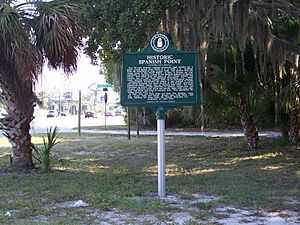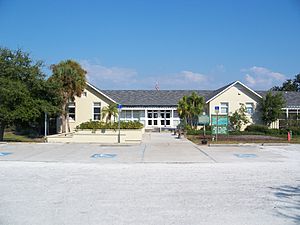Historic Spanish Point facts for kids
| Established | 1982 |
|---|---|
| Location | 401 North Tamiami Trail Osprey, Florida |
| Type | Archaeological museum and botantical garden |
| Owner | Marie Selby Botanical Gardens |
| Public transit access | Sarasota County Area Transit |
|
Osprey Archeological and Historic Site
|
|
| NRHP reference No. | 75000569 |
| Added to NRHP | April 16, 1975 |
Historic Spanish Point is a 33-acre (13 ha) museum and nature area in Osprey, Florida. It's a great place to learn about Florida's past. You can explore an ancient shell mound, which is like a giant pile of shells left by early people. There's also a pioneer home from the early 1900s, a citrus packing house, a chapel, and beautiful gardens with nature trails.
Contents
Discovering the Past: A Look at History
Historic Spanish Point has a very long history, going back about 5,000 years. People lived here for thousands of years, from ancient times until about 1,000 years ago. These early people were not always moving around. They learned to use clay pots and settled down in one place. They used the rich resources from the Gulf of Mexico, marshes, forests, and bays. They also developed special tools to help them live. These early communities disappeared from the area before the year 1100 AD.
Who Lived Here? The Webb Family and Bertha Palmer
In the 1800s, a family named Webb moved from New York to start a farm here. A Spanish trader told them about this high piece of land by the bay. So, the Webbs named their new home "Spanish Point." The Webb family grew citrus fruits, sugar cane, and vegetables. They even built a packing house to get their crops ready for sale. Later, in the early 1900s, the Webbs sold parts of their land to other new settlers.
In 1910, a very wealthy woman from Chicago named Bertha Palmer bought the Spanish Point homestead. She also bought thousands of acres for cattle, citrus trees, and building new homes. The Webb family's old home became part of her large 360-acre (150 ha) estate, which she called "Osprey Point." Mrs. Palmer kept the old pioneer buildings. She also added fancy gardens and lawns to connect them. Mrs. Palmer passed away in 1918. Her family kept Osprey Point. In 1959, her grandson, Gordon Palmer, helped fund a three-year dig at the ancient site. Today, this site is where the museum at Historic Spanish Point stands.
Gordon's wife, Janis, and other family members helped get Spanish Point recognized. In 1975, it became the first place in Sarasota County to be listed on the National Register of Historic Places. This means it's a very important historical site. In 1980, the Palmer family gave the site to the Gulf Coast Heritage Association. In May 2020, Historic Spanish Point joined the Marie Selby Botanical Gardens.
Exploring the Exhibits: What Can You See?
Historic Spanish Point has many interesting places to explore. Each one tells a part of the area's long history.
The Osprey School and Entrance Cottage
- Visitors’ Center at Osprey School: This building was one of five schools built between 1926 and 1928. It helped teach the growing number of children in Sarasota County. The school was designed in a Spanish style and is also listed on the National Register of Historic Places. It used to be the Visitors' Center for Historic Spanish Point. Now, it is the Osprey Public Library.
- Entrance Cottage: This small building is right at the start of the historic site.
Gardens and Natural Beauty
- The Gazebo: This gazebo looks like one that was part of Mrs. Palmer's estate. It has many native ferns, trees, and air plants.
- Palmer Water Garden: Mrs. Potter Palmer created this beautiful water garden, also called the Ornamental Pond, for her estate.
- Butterfly Garden: This garden is designed to help butterflies at every stage of their lives. You can see plants here that butterflies eat as caterpillars and plants that provide nectar for adult butterflies.
- Fern Walk: You enter the Fern Walk under an aqueduct. This area is a natural hollow in the ancient shell mound. It features beautiful ferns and palm trees.
- Jungle Walk and Aqueduct: Mrs. Bertha Palmer created the Jungle Walk. It has shell paths that wind through tropical plants. A small aqueduct has water flowing over a shell waterfall.
- Sunken Garden and Pergola: Mrs. Bertha Palmer created the Sunken Garden between 1912 and 1915. It was a formal garden within the natural Florida environment. The Pergola next to it offered views of the bay. Today, it's a popular spot for weddings.
Ancient History: Mounds and Early People
- Burial Mound: Many generations of early Native Americans built this mound. They lived along the Shell Ridge Midden from about 300 to 1000 AD. They would place human bones and special offerings, like shark teeth and broken pottery, on the mound. Then, they would cover them with sand.
- Archaic Midden: This is the oldest shell mound at Historic Spanish Point, dating back to before 3000 BC. It is believed to have been built by the Calusa people. The Archaic Midden is made of layers of shells, shell tools, pottery, and other old items. It's the only archaeological exhibit in the United States that is built inside an ancient shell mound.
- A Window to the Past: This exhibit is inside a prehistoric shell mound. It has a video that tells about the first people who lived at Historic Spanish Point. You can also see a model of an ancient home, other exhibits, and interactive displays.
- Shell Ridge Midden: The highest part of the Shell Ridge Midden was created by early inhabitants. It might have been a platform for a chief's home or a temple. The Webb family also built their home here in 1867.
Pioneer Life and Buildings
- Webb Packing House: In this building, citrus fruits were washed, prepared, sorted, and packed into crates. They were then shipped to markets up north. This building is a true copy of the original packing house.
- Mary's Chapel: This chapel is named for Mary Sherrill, a young woman who passed away while staying at the Webbs' Winter Resort. The chapel was rebuilt in 1986. It has six stained-glass windows saved from the original building. It's a popular place for small weddings.
- Pioneer Cemetery: Next to Mary's Chapel is the family graveyard. Members of the Webb family and other early settlers are buried here.
- Guptill House: Frank and Lizzie Webb Guptill built their home on the ancient Archaic Midden in 1901. They rented rooms to people visiting in the winter. Ten years later, Mrs. Potter Palmer bought the home and called it Hill Cottage. The Guptill House is decorated to show what a Florida pioneer home looked like.
- Pioneer Boat Yard: For early settlers along Florida's coast, the local bays and the Gulf of Mexico were very important. The Webb family's home depended on water resources, boats, and trade by sea. Frank Guptill ran his boatyard near where this working boatyard is built today.
- Point Cottage: This house was built in 1931 for Potter Palmer III and his wife. It was later used by Potter's sister, Bertha. Today, it is a center for educational programs.
- White Cottage: Jack Webb built this building in 1884. In the 1890s, it became "The Dormitory" for the Webbs' Winter Resort. The first floor has exhibit galleries. The second floor has a research center that you can visit by appointment.
Boats and Waterways
- Magic : This boat is a copy of a sailboat that John Webb changed into a motorboat around 1900. When it's not out on the bay, Magic is docked near the Packing House pier. John Webb's grandson, Charles Webb, used Magic to take guests around and entertain them. For many years, no one knew what happened to the original Magic. But recently, Charles Webb's handwritten journal was found. In it, he wrote that a hurricane in 1921 completely destroyed the boat.
- Cock's Footbridge: Daniel Cock built the first Footbridge in the late 1890s. His boarding house, "Fiddler's Lodge," was at its northern end. Today, this bridge gives you a great view of the mangrove shoreline and where the Lizzie G. and other wooden boats are docked.
- Lizzie G. : This sailboat is a working copy of an 1890s boat. Master boat builder Stan Lowe designed it. Volunteers at Historic Spanish Point built it using old-fashioned tools and methods. The wood came from local trees and was shaped by hand. No power tools were used to build the Lizzie G.. Its sails are made of hand-stitched cotton.



